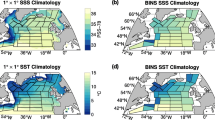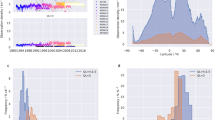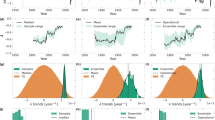Abstract
Meteorological and oceanographic data from ships of opportunity are the largest contributor to the world’s ocean surface database and thus are extensively used to estimate the change in climatic properties over the world’s oceans during the previous 150 years. The importance of these data for climate change studies underscores the need to fully understand the error associated with averages of these data. The sampling error problem is especially acute for ship data due to the fact that ships are moving platforms and, thus, report observations from constantly varying locations with time. This paper develops a theoretical framework for assessing the averaged sampling error associated with monthly, 1°×1° latitude-longitude box averaged ship data. It should be noted that the time-space distribution of ships within the averaging domain strongly affects the sampling error. This is shown in our derivation. The framework developed here can be used to improve upon existing methods for estimating the sampling error associated with three-dimensional box averages of meteorological and oceanographic data obtained from ship records. The framework is complimentary to existing methods of assessing biases and random error due to instrumentation, recording, etc. It is demonstrated mathematically that the uncertainty due to incomplete sampling is primarily a trade off between of the number of observations and their relative locations within the box as well as the inherent time-space correlation structure of the variable of interest. This work differs from other studies in that the three-dimensional interdependence of data is taken into account in deriving an expression for the sampling error.






Similar content being viewed by others
Notes
For simplicity we will hereafter allow \({\mathbf{Cov}}\left[ {R\left( {{\text{p}}\left( {\text{i}} \right){\text{,}}\,M} \right),R\left( {{\text{p}}\left( {\text{k}} \right){\text{,}}\;M} \right)} \right]\) to equal \({\text{Cov}}\left[ {\left| {{\text{p}}\left( {\text{i}} \right) - {\text{p}}\left( {\text{k}} \right)} \right|} \right]\)
References
Briffa KR, Jones PD (1990) Basic chronology statistics and assessment. In: Cook E, Kairiukstis L (eds) Methods of dendrochronology: applications in the environmental sciences. Kluwer, Dordrecht, The Netherlands, pp 137–152
Brohan P, Kennedy JJ, Harris I, Tett SFB, Jones PD (2006) Uncertainty estimates in regional and global observed temperature changes: a new data set from 1850. J Geophys Res 111:12,106–12,127
Cayan D (1992) Variability of latent and sensible heat fluxes estimated using bulk formulae. Atmos Ocean Techn 301–42
Cressie N, Huang H (1999) Class of nonseparable, spatio-temporal stationary covariance functions. J Am Stat Assoc 95:1330–1340
De Luna X, Genton MG (2005) Predictive spatio-temporal models for spatially sparse environmental data. Stat Sin 15:547–568
Folland CK, Parker DE (1995) Correction of instrumental biases in historical sea-surface temperature data. Q J R Meteorol Soc 121:319–367
Grebremichael M, Krajewski WF, Morrissey M, Langerud D, Huffman GJ, Adler R (2003) Error uncertainty analysis of GPCP monthly rainfall products: a data based simulation study. J Appl Meteorol 42(12):1837–1848
Gneiting T (2002) Nonseparable, stationary covariance function for space-time data. J Am Stat Assoc 97:590–600
Gneiting T, Genton MG, Guttorp P (2007) Geostatistical space-time models, stationarity, separability and full symmetry. In: Finkenstadt B, Held L, Isham V (eds) Statistical methods for spatio-temporal systems, CRC, Boca Raton, FL, USA, pp 151–175
Gulev SK, Hasse L (1998) North Atlantic wind waves and wind stress fields from voluntary observing ship data. J Phys Oceanogr 28:1107–1130
Jones PD (1994) Hemispheric surface air temperature variations: a reanalysis and an update to 1993. J Climate 7:1794–1802
Jones PD, Osbborn TJ, Briffa KR (1997) Estimating sampling errors in large-scale temperature averages. J Climate 10:2548–2568
Journel AG, Huijbregts ChJ (1989) Mining geostatistics. Academic, San Diego, CA, USA, 600 pp
Kagan RL (1997) Averaging of meteorological fields. Kluwer, Dordrecht, The Netherlands, 279 pp
Kent KC, Challenor PG, Taylor PK (1999) A statistical determination of the random observational errors present in voluntary observing ships meteorological reports. J Atmos Oceanic Tech 16:905–914
Krajewski WF, Ciach GJ, McCollum JR, Bacotiu C (2000) Initial verification of the Global Precipitation Climatology Project monthly rainfall over the United States. J Appl Meteor 39:1071–1086
Kyriakidis PC, Journel AG (1999) Geostatistical space–time models: a review. Math Geol 31:6651–684
Legler D (1991) Errors in five-day mean surface wind and temperature conditions due to inadequate sampling. J Atmos Oceanic Technol 8:705–712
Lu N, Zimmerman DL (2005) Testing for directional symmetry in spatial dependence using the periodogram. J Stat Plan Infer 129:369–385
May DR, Julian PY (1998) Eulerian and Lagrangian correlation structures of convective rainstorms. Water Resour Res 34:2671–2683
Morrissey ML (1991) Using sparse raingauges to calibrate satellite-based rainfall algorithms. J Geophys Res Atmos 96:18561–18571
Morrissey ML, Greene JS (1993) A comparison of two satellite-based rainfall algorithms using Pacific atoll raingauge data. J Appl Meteorol 32(2):411–425
Morrissey ML, Greene JS (1998) Uncertainty of satellite rainfall algorithms over the tropical Pacific. J Geophys Res 103:19,569–19,576
Morrissey ML, Maliekal JA, Greene JS, Wang J (1995) The uncertainty of simple spatial averages using rain gauge networks. Water Resour Res 31:2011–2017
Parker DE (1984) The statistical effects of incomplete sampling of coherent data series. J Climatol 4:445–449
Parker DE, Horton B (2005) Uncertainties in central England 1878-2003 and some improvements to the maximum and minimum series. Int J Climatol 25:1173–1188
Rodríguez-Iturbe I, Mejía JM (1974) The design of rainfall networks in time and space. Water Resour Res 10(4):713–728
Scaccia L, Martin RJ (2005) Testing axial symmetry and separability of lattice processes. J Plann Infer 131:19–39
Smith TM, Reynolds RW (2005) A global merged land-air-sea surface temperature reconstruction based on historical observation (1880-1997). J Climate 18:2021–2036
Stein ML (2005) Space-time covariance functions. J Am Stat Assoc 100:310–321
Trenberth KE (1984a) Some effects of finite sample size and persistence on meteorological statistics, part I: autocorrelations. Mon Weather Rev 112(12):2359–2368
Trenberth KE (1984b) Some effects of finite sample size and persistence on meteorological statistics, part II: potential predictability. Mon Weather Rev 112(12):2369–2379
Wigley TML, Briffa KR, Jones PD (1984) On the average value of correlated time series, with applications in dendroclimatology and hydrometeorology. J Clim Appl Meteorol 23:201–213
Wolter K (1997) Trimming problems and remedies in COADS. J Climate 10:1980–1997
Woodruff SD (2001) COADS updates including newly digitized data and the blend with the UK meteorological office marine data bank and quality control in recent COADS updates. Proceedings of Workshop on Preparation, Processing and Use of Historical Marine Meteorological Data, Tokyo, Japan, 28–29 November 2000, Japan Meteorological Agency and the Ship and Ocean Foundation, Tokyo, pp 9–53
Woodruff SD, Slutz RJ, Jenne RL, Steurer PM (1987) A comprehensive ocean-atmosphere data set. Bull Am Meteorol Soc 68:1239–1250
Acknowledgements
The authors would like to thank those who attended the Brussels CLIMAR-II Conference held in 2003 for their encouragement to pursue this work. We also would like to acknowledge the generous help from NOAA’s Climate and Global Change Program’s Climate Observations Element contract number NA17RJ1227. Thanks also go out to M. Klatt for his help in organizing the data.
Author information
Authors and Affiliations
Corresponding author
Rights and permissions
About this article
Cite this article
Morrissey, M.L., Greene, J.S. A theoretical framework for the sampling error variance for three-dimensional climate averages of ICOADS monthly ship data. Theor Appl Climatol 96, 235–248 (2009). https://doi.org/10.1007/s00704-008-0027-3
Received:
Accepted:
Published:
Issue Date:
DOI: https://doi.org/10.1007/s00704-008-0027-3




